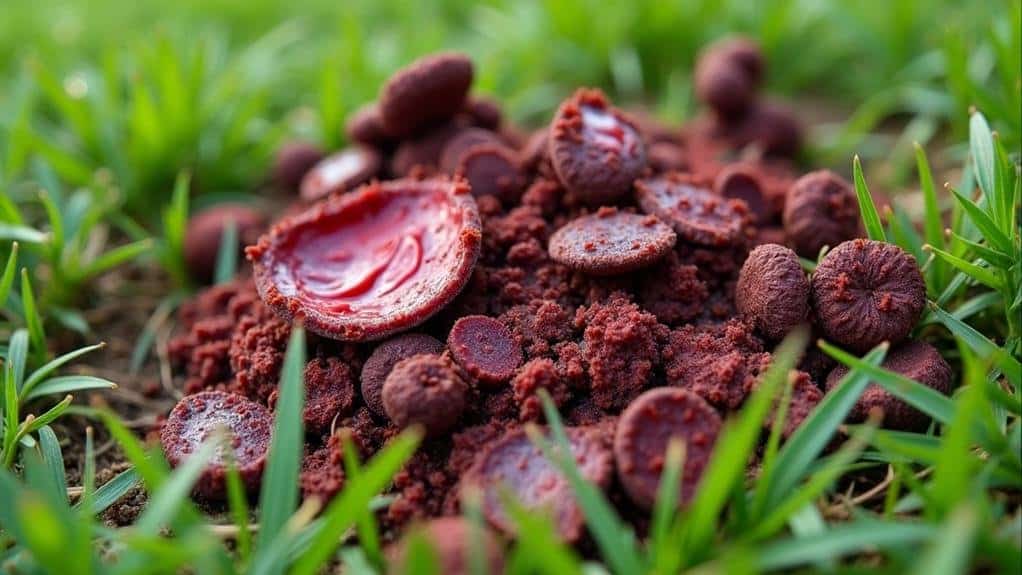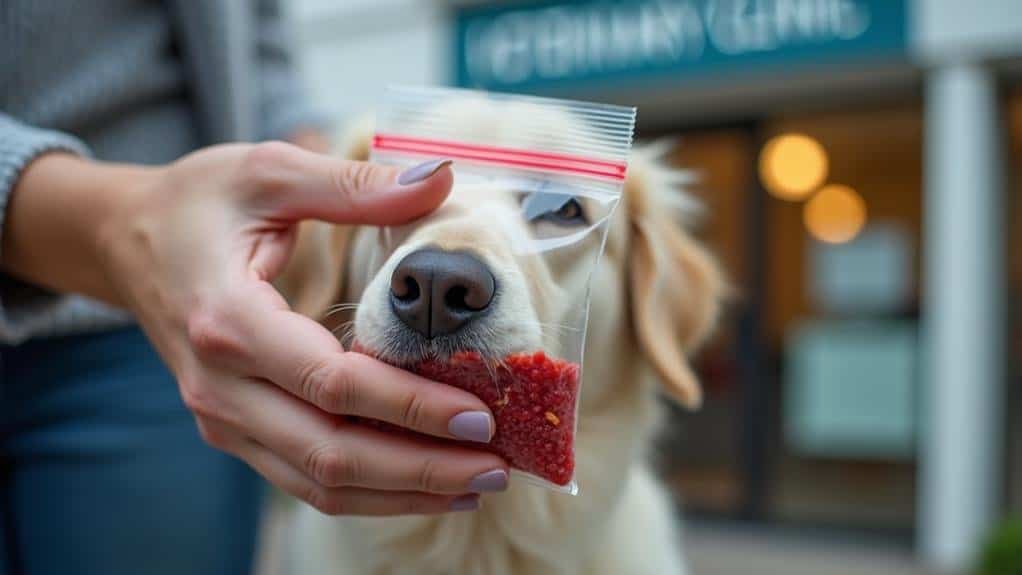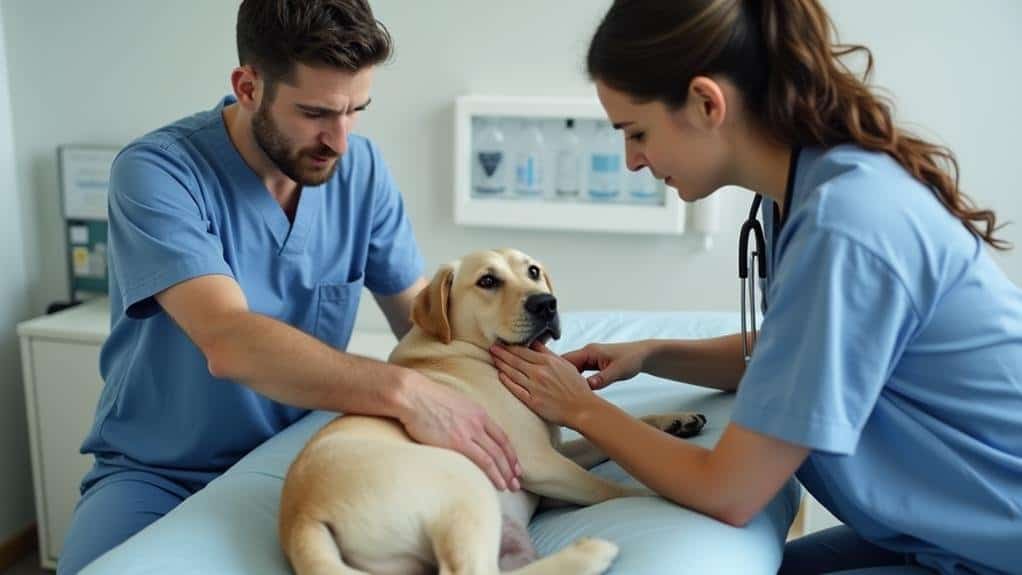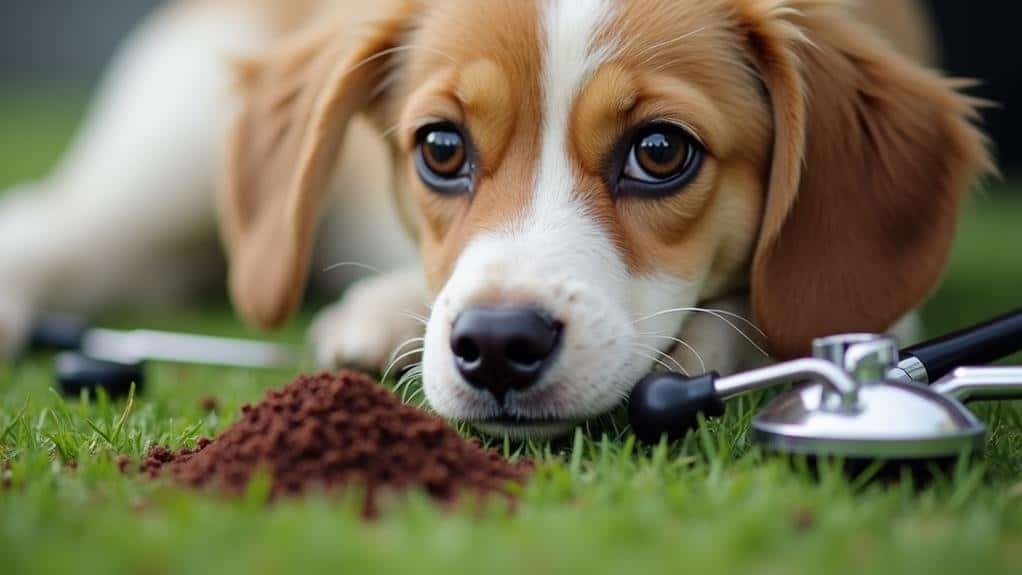If you’ve noticed blood in your dog’s poop, don’t panic, but do take it seriously.
There are several potential causes, ranging from minor dietary issues to more serious health concerns.
The type of blood you see can offer clues: bright red blood might indicate lower digestive tract problems, while dark, tarry stools suggest upper GI bleeding.
Watch for accompanying symptoms like diarrhea, vomiting, or lethargy. While some cases resolve on their own, it’s always best to consult your vet, especially if symptoms persist or worsen.
They can perform tests to pinpoint the cause and recommend appropriate treatment.
Common Causes of Bloody Stools

Your dog’s bloody stools can be alarming, but they’re often caused by common issues. Let’s explore the most frequent culprits behind blood in your dog’s stool:
1. Dietary Indiscretion: If your furry friend has a taste for garbage or spoiled food, it can lead to gastrointestinal inflammation and bleeding.
It’s like they’ve got a case of doggy food poisoning!
2. Internal Parasites: Uninvited guests like hookworms and giardia can wreak havoc on your pup’s intestines, causing bloody stools along with weight loss and lethargy.
3. Inflammatory Conditions: Inflammatory bowel disease and colitis can turn your dog’s potty breaks into a red-flag situation, often producing bright red blood in their stools.
4. Toxic Substances: From certain plants to rat poison, ingested toxins can irritate your dog’s digestive system and disrupt blood clotting, leading to gastrointestinal bleeding.
5. Physical Trauma: Accidents happen, and sometimes they result in internal bleeding that shows up in your dog’s poop.
Types of Blood in Dog Poop

Bloodhounds aren’t the only dogs that can leave you seeing red. When you notice blood in your dog’s poop, it’s vital to understand what you’re dealing with.
There are two main types of bloody stools you might encounter:
- Hematochezia: This is characterized by bright red blood in your dog’s poop. It’s often a sign of bleeding from the lower gastrointestinal tract, which could be caused by conditions like colitis or injuries to the rectum. If you see fresh blood, it might indicate an acute problem such as hemorrhagic gastroenteritis.
- Melena: If your dog’s poop looks dark and tarry, you’re likely seeing melena. This occurs when blood has been digested and typically points to issues in the upper digestive tract, like ulcers or tumors.
The appearance of the blood can tell you a lot. Streaks in firm stools or blood mixed throughout diarrhea can provide clues about the underlying cause.
A fecal examination by your vet is vital for diagnosing gastrointestinal issues. Remember, whether it’s fresh blood or digested, any bloody diarrhea warrants a trip to the vet.
Accompanying Symptoms to Watch For

Several key symptoms can accompany bloody stools in dogs, and it’s crucial to watch for these signs. If you notice blood in your dog’s stool, be on the lookout for accompanying symptoms like diarrhea, vomiting, or lethargy.
These additional issues often indicate a more serious condition that requires immediate veterinary attention.
Keep an eye out for signs of dehydration, which can go hand-in-hand with bloody stools. Check your pup’s gums for dryness, and monitor their water intake and urination frequency.
If you notice excessive thirst or decreased urination, it’s time to call the vet.
Another red flag is tenesmus, where your dog strains to poop but produces little or no stool. This can be a sign of severe gastrointestinal distress when combined with bloody stools.
Don’t ignore any sudden behavioral changes either. If your normally playful pooch becomes irritable or less active, it could signal a worsening condition.
When to Seek Veterinary Care

At the first sign of blood in your dog’s stool, it’s important to contemplate seeking veterinary care.
Blood in dogs’ poop can indicate serious health issues that shouldn’t be ignored. If you notice bright red or dark, tarry blood in your furry friend’s stool, it’s time to contact your veterinarian. They’ll help determine if it’s coming from the upper or lower digestive tract.
When to seek immediate attention:
- Young puppies with bloody stool: These little ones are at risk for life-threatening conditions like parvovirus.
- Multiple symptoms: If your dog’s bloody stool is accompanied by vomiting, lethargy, or loss of appetite, urgent veterinary intervention is vital.
- Signs of severe distress: Weakness, dehydration, or any drastic change in your dog’s overall condition warrants emergency veterinary care.
Diagnostic Procedures for Bloody Stools

Determining the cause of bloody stools in dogs requires a thorough diagnostic approach. Your veterinarian will start by taking a detailed medical history of your pet, asking about recent dietary changes, possible ingestion of foreign objects, and vaccination status. This information is essential for an accurate diagnosis of your pet’s condition.
Next, your vet will likely perform several diagnostic procedures to pinpoint the cause of the bloody stools:
- Stool examinations: These tests can identify parasites, bacteria, and blood in your dog’s feces, helping to diagnose issues in the digestive tract.
- Blood work: This assesses your pet’s hydration status, organ function, and can detect infections or inflammatory conditions that might be causing the problem.
- Imaging techniques: X-rays or ultrasounds may be used to visualize your dog’s gastrointestinal tract, looking for tumors, blockages, or other abnormalities.
- Advanced procedures: In some cases, more invasive diagnostics like endoscopy or colonoscopy might be necessary to directly examine the digestive tract lining.
These steps help your vet determine if your furry friend is dealing with something simple like dietary indiscretion or a more serious condition like acute hemorrhagic diarrhea.
Treatment Options and Management

Treatment options for dogs with bloody stools typically depend on the underlying cause identified during diagnosis. Your veterinarian will recommend a tailored approach to address your furry friend’s specific condition.
Here are some common treatments:
1. Dietary Changes and Medications
If inflammation is the culprit, your vet might suggest a bland diet and anti-inflammatory medications. These can help soothe your pup’s upset tummy and reduce irritation.
2. Hydration Support
In cases of severe diarrhea, your dog might need fluids to combat dehydration. Don’t worry, it’s just like a doggy spa day with an IV!
3. Parasite Busters
If those pesky parasites are causing trouble, anti-parasitic treatments will send them packing. Goodbye, unwanted guests!
4. Antibiotics
For bacterial infections or anal sac issues, antibiotics might be prescribed. They’re like tiny soldiers fighting off the bad guys in your dog’s gut.
5. Surgical Intervention
In more serious cases involving tumors or severe internal bleeding, surgery might be necessary. It’s not ideal, but sometimes it’s the best way to get your pup back on their paws.
Prevention and Long-Term Care

Prevention is the best medicine when it comes to keeping your dog’s poop blood-free. To safeguard your furry friend’s health, start with regular veterinary check-ups. These visits can catch potential issues early, before they turn into serious problems that might lead to bloody stools.
Next, focus on maintaining an appropriate diet for your pup. A consistent, well-balanced meal plan can prevent tummy troubles that often result in digestive upset and, you guessed it, bloody poop.
Don’t forget about those routine fecal examinations and deworming treatments, either! They’re essential for keeping pesky internal parasites at bay, which can cause inflammation and bleeding in your dog’s digestive tract.
Create a safe environment for your four-legged friend by:
- Removing harmful objects or substances they might ingest
- Monitoring their behavior closely
- Keeping an eye on their stool consistency
Frequently Asked Questions
What Should I Do if My Dog Poops Blood?
If your dog poops blood, contact your vet immediately. Collect a stool sample and monitor your pet’s condition closely. Note any recent dietary changes or ingested objects. Seek urgent care if it’s a puppy or other symptoms arise.
Is Bloody Diarrhea an Emergency for Dogs?
Yes, bloody diarrhea in dogs is an emergency. You should take it seriously and seek immediate veterinary care. Don’t wait, as it could indicate severe health issues. Quick action is essential for your dog’s well-being and recovery.
What Does It Mean When a Dog Passes Blood in His Stool?
When your dog passes blood in his stool, it’s a sign of gastrointestinal issues. You’ll need to watch for other symptoms and consider the color of the blood. It’s best to consult your vet for proper diagnosis and treatment.
Why Is My Dog Pooping Bloody Diarrhea but Acting Normal?
Your dog’s bloody diarrhea with normal behavior could indicate mild inflammation or irritation in the lower digestive tract. It might be due to dietary issues, minor infections, or parasites. However, you should still consult a vet for proper diagnosis.
Conclusion
You’ve learned about the various causes of bloody stools in dogs, from minor issues to serious conditions.
Remember, it’s essential to monitor your pup’s symptoms and seek veterinary care when necessary. By understanding the types of blood, accompanying signs, and potential treatments, you’re better equipped to handle this alarming situation.
With proper care and prevention, you can help guarantee your furry friend stays healthy and happy.
Don’t hesitate to consult your vet if you’re ever unsure – your dog’s well-being is worth it!

